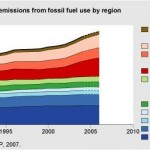
India’s per capita emission of Greenhouse Gases (GHG) will continue to be low until the year 2030-31. In fact, it is estimated that India’s per capita emissions in the year 2031 will be lower than the per capita global emission of GHG in the year 2005.
These significant findings were contained in a Report “India’s GHG Emissions Profile: Results of Five Climate Modelling Studies” released in November 2009 by the Deputy Chairman of the Planning Commission, Montek Singh Ahluwalia. The Minister of Environment & Forests (MoEF), Jairam Ramesh, had presided over the function. The Chairman of Unique Identity Authority of India, Nandan Nilekani, was also present on the occasion.
As per the estimates of the five different studies, India’s per capita GHG emissions in 2030-31 would be between 2.77 tonnes and 5.00 tonnes of CO2e (Carbon Dioxide equivalent). Four of the five studies estimated that even in 2031, India’s per capita GHG emissions would stay under 4 tonnes of CO2e, which is lower than the global per capita emissions of 4.22 tonnes of CO2e in 2005. This would mean that even two decades from now, India’s per capita GHG emissions would be well below the global average of 25 years earlier.
In absolute terms, estimates of India’s GHG emissions in 2031 vary from 4.0 billion tones to 7.3 billion tones of CO2e, with four of the five studies estimating that even two decades from now, India’s GHG emissions will remain under 6 billion tones. The key drivers of the range of these estimates are the assumptions on GDP growth rates, penetration of clean energy, energy efficiency improvements, etc.
All the five studies show evidence of a substantial and continuous improvement in India’s energy efficiency of GDP. India’s energy use efficiency has been steadily improving over the years, which is reflected in the decline of its energy intensity of GDP from 0.30 kgoe (kilogram of oil equivalent) per $ of GDP in 1980 to 0.16 kgoe per $ GDP in PPP (purchasing power parity) terms. This is comparable to Germany, and only Japan, U.K., Brazil and Denmark have lower energy intensities in the world. An Enhanced Energy Efficiency Mission has also been approved in principle under the National Action Plan on Climate Change.
Of the five studies on GHG emissions profile in India, three were conducted by the National Council of Applied Economic Research (NCAER) – Jadavpur University, The Energy Research Institute (TERI) and the Integrated Research and Action for Development (IRADe) with the support of the Ministry of Environment & Forests. Two other studies by TERI and Mckinsey and Company were conducted with support from other agencies. These studies were taken up with a view to develop a fact-based perspective on climate change in India that clearly reflects the realities of its economic growth, the policy and regulatory structures, and the vulnerabilities of climate change.
The Ministry of Environment & Forests functioned as the facilitator, bringing together the five studies undertaken independently, enabling a thorough review process and publishing the results with a view to generate a meaningful and informed dialogue on the subject of climate change.
Check the following link to read/download the Full Study:
http://moef.nic.in/downloads/home/GHG-report.pdf
Source: Ministry of Environment & Forests, Government of India.














